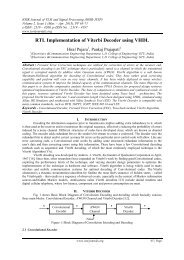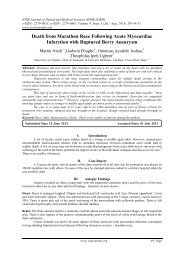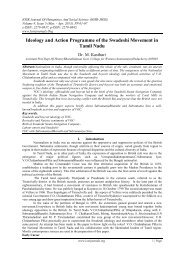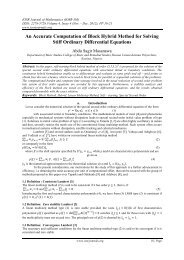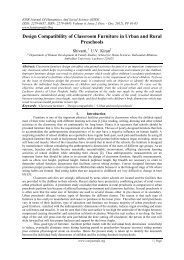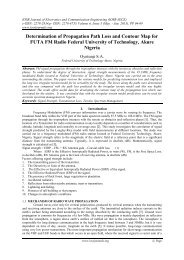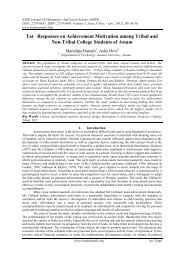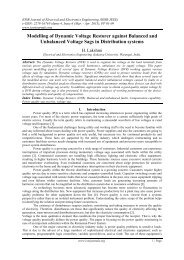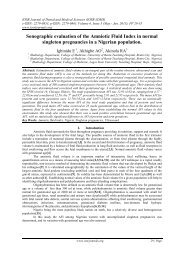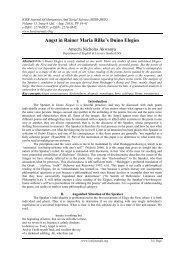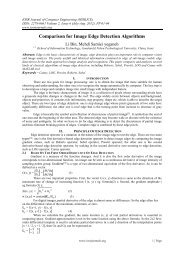Initial Conquest of India by Turks and Their Slaves - IOSR
Initial Conquest of India by Turks and Their Slaves - IOSR
Initial Conquest of India by Turks and Their Slaves - IOSR
Create successful ePaper yourself
Turn your PDF publications into a flip-book with our unique Google optimized e-Paper software.
Local perspective, aspiration <strong>and</strong> women empowerment in housing development in Africa: Nigeria<br />
environment. Of importance here are planning policies, architecture <strong>and</strong> design. These are argued to be gender<br />
blind (Wood, 1994).<br />
An exception to the research orientation common in the developing countries is Agbola‟s work (1990b)<br />
<strong>and</strong> Olatubara‟s work (2003) in which they examined the role <strong>of</strong> women in housing development <strong>and</strong> women<br />
participation in residential location decision-making respectively in Ibadan, Oyo State, Nigeria. Agbola (1990b)<br />
observes that most women living with their husb<strong>and</strong>s show alarming disinterestedness in the l<strong>and</strong> acquisition<br />
process <strong>and</strong> contribute relatively minimally to the finance <strong>of</strong> the building. Women-headed households<br />
shouldered the whole responsibility themselves at all stages <strong>of</strong> the housing development process. He also<br />
observes that women pr<strong>of</strong>essionals are few <strong>and</strong> those living with their husb<strong>and</strong>s assist their husb<strong>and</strong>s in l<strong>and</strong><br />
acquisition <strong>and</strong> finance. Women on construction sites are found to be mostly uneducated, earns very low income<br />
which is <strong>of</strong>ten used for food to feed the family. He observes that women are more involved in housing<br />
maintenance than in any other housing development activities. He notes further that top on the list <strong>of</strong> problems<br />
inhibiting women‟s participation in the housing development was male dominance, followed <strong>by</strong> poverty, lack <strong>of</strong><br />
concern <strong>and</strong> illiteracy respectively (Agbola, 1990). Olatubara‟s work examines the level <strong>of</strong> women‟s<br />
participation in the choice <strong>of</strong> where the household resides in the urban centre <strong>and</strong> which house is selected as<br />
well as the association between decision-making on choice <strong>of</strong> residential district <strong>and</strong> age <strong>of</strong> the respondent, rent<br />
contribution <strong>by</strong> respondent, position <strong>of</strong> wife, availability <strong>of</strong> vehicle in the household, residential density <strong>and</strong><br />
income <strong>of</strong> respondent. His findings shows male dominance in decision-making, significant joint decision<br />
between husb<strong>and</strong> <strong>and</strong> wife <strong>and</strong> the economic status <strong>of</strong> the women as an important factor that makes them to<br />
participate more or less in residential location decision (Olatubara, 2003).<br />
Findings from the study from which the data for this paper is derived have shown among others that<br />
there is low involvement <strong>of</strong> women in housing development; the general perception <strong>of</strong> women is that housing<br />
provisions are the responsibilities <strong>of</strong> male head <strong>of</strong> households; building activities are viewed more as men‟s job;<br />
men are found to have applied more for building plan registration <strong>and</strong> certificates <strong>of</strong> occupancy than women;<br />
men are found to own more plots <strong>of</strong> l<strong>and</strong>, more number <strong>of</strong> houses <strong>and</strong> housing plots than women (Asiyanbola<br />
<strong>and</strong> Filani, 2007; 2008a; 2008b). Thus as shown in the literature, the local perspective is that male head <strong>of</strong><br />
household dominate decisions on critical aspects <strong>of</strong> housing development.<br />
The second aim <strong>of</strong> the paper is to examine the influence <strong>of</strong> local perspective on housing development<br />
involvement aspiration <strong>of</strong> women as indicated <strong>by</strong> the actual housing development involvement <strong>of</strong> women,<br />
women‟s level <strong>of</strong> knowledge about the development <strong>of</strong> their household house, <strong>and</strong> women‟s intension to be<br />
involved in housing delivery. This aim builds on the existing works <strong>by</strong> providing insight on the influence <strong>of</strong><br />
local perception on the housing development involvement aspiration <strong>of</strong> women in Nigeria. The importance <strong>of</strong><br />
this aim lies in the fact that in sociological <strong>and</strong> psychological tradition there has been a widespread acceptance<br />
<strong>of</strong> the assumption that there is a close correspondence between the ways in which a person behaves towards<br />
some object <strong>and</strong> his/her (sic) beliefs, feelings <strong>and</strong> intentions with respect to that object (Fishbein <strong>and</strong> Ajzen,<br />
1975:336). Indeed, Allport (1968) attributes to Plato the idea that the mind is constituted <strong>of</strong>, <strong>and</strong> human action<br />
determined <strong>by</strong>, the three faculties <strong>of</strong> affection (feeling), conation (striving) <strong>and</strong> cognition (thought). Although<br />
the relationship between some attitudes <strong>and</strong> expected behaviour has proved to be less than ideal, “the best single<br />
predictor <strong>of</strong> an individual‟s behaviour will be a measure <strong>of</strong> his (sic) beliefs, feelings <strong>and</strong> intention to perform<br />
that behaviour (Fishbein <strong>and</strong> Ajzen, 1975; Merlo <strong>and</strong> McDonald, 2002). It is in these traditions that the study<br />
seeks to examine the influence <strong>of</strong> the local perspective as reflected <strong>by</strong> the general beliefs <strong>and</strong> feelings about<br />
women‟s involvement in housing development on actual housing development involvement <strong>of</strong> women,<br />
women‟s level <strong>of</strong> knowledge about the development <strong>of</strong> their household house <strong>and</strong> women‟s intension to be<br />
involved in housing delivery. The null hypotheses tested in the paper is that there is no significant relationship<br />
between the local perspective on women‟s involvement in housing development <strong>and</strong> (i) actual housing<br />
development involvement <strong>of</strong> women, (ii) women‟s level <strong>of</strong> knowledge about the development <strong>of</strong> their<br />
household house, <strong>and</strong> (iii) women‟s intension to be involved in housing delivery.<br />
Ibadan city, which is the case study, is located in the South-western part <strong>of</strong> Nigeria. The total<br />
population size <strong>of</strong> the wider Ibadan region was 1,258,625 according to the 1963 census <strong>and</strong> 1,991,367 in 1991<br />
out <strong>of</strong> which 988,923 are male while 1,002,444 are female (Afolayan, 1994). The city was for a long time the<br />
largest city in tropical Africa. Although, it has now been surpassed <strong>by</strong> Lagos, it remains a truly Nigerian city.<br />
By virtue <strong>of</strong> its historical, political, administrative, cultural <strong>and</strong> socio-economic importance over the years, there<br />
is hardly any major ethnic or sub-ethnic group in Nigeria that is not represented in this city (Mabogunje 1968;<br />
Filani et al 1994). Thus any study undertaken in the city can mirror what happens to women <strong>of</strong> diverse ethnic<br />
origin in Nigeria. It is important to note that the literature on this important city is ever exp<strong>and</strong>ing representing<br />
different academic <strong>and</strong> research interests (see, Filani et al 1994).<br />
www.iosrjournals.org<br />
17 | Page



